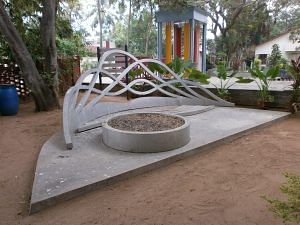
Also read: KCS Paniker’s paintings moved between metaphysical & abstract. They redefined Modern Indian Art
Located on India’s southeastern coast at Injambakkam village, approximately nine kilometres from Chennai, Cholamandal is spread over 10 acres of land. Besides housing, the community artists’ studios for rent, a permanent contemporary art gallery of sculpture, painting, graphics and drawings, Artists’ Handicrafts Association offices, a metalsmith workshop and Bharathi, an open-air theatre where discussions and conferences are held. The maintenance of the artists’ studios was initiated by the artists as a collective with zero involvement of private or public institutions. The artists who inhabited (and some who currently inhabit) the village live in basic thatched-roof cottages built with bamboo. In order for the artists to sustain themselves, it was decided that artists would produce handicrafts alongside working on their practice. The earnings went into a collective fund from which the artists drew funds for sustenance.
The village also holds an international sculpture park with artworks from international artists who have either visited Cholamandal through cultural exchange programmes and organisations or on their own accord. Cholamandal also began publishing an art journal, Artrends, which provided the artists with a public stage to present their accomplishments both in India and internationally. The Progressive Painters Association (1972), which rose out of Cholamandal, is largely attributed to creating “small format” artworks or miniatures that are more accessible to the public. These were sold in an exhibition called Contemporary Miniatures (2014), which also travelled to other parts of the country.
The village received international acclaim on platforms such as the Venice Biennale, Paris Biennale and the Commonwealth Art Festival London. In 2018, artists living and working in Cholamandal exhibited their works at the Forum Art Gallery Chennai. The village also holds the Museum of the Madras Movement, which is held within the Cholamandal Centre for Contemporary Art –– established in 2009 to give space to pioneering artists of the “Madras Movement” –– as well as two commercial galleries, Indigo and Laburnum.
Today, the village is a major tourist attraction in Chennai. The original format of Cholamandal as a commune has shifted, and it is now primarily inhabited by homeowners who lease their homes to artists. However, the Artists Handicrafts Association continues to oversee the colony. Moreover, the village is no longer accepting new artists –– an aspect that has been highly criticised by scholars and artists alike –– even though the numbers have dwindled from forty to twenty-one.
Some of the notable names to emerge from the village, apart from Paniker, are Velu Viswanathan, M Senathipathi and P Krishnamoorthy, who was the Secretary of the village from 1964–70; they are also credited with initiating the Madras School art movement. Other artists who were part of the village include J Sultan Ali, M Redeppa Naidu and Akkitham Narayanan.
This article is taken from the MAP Academy‘s Encyclopedia of Art with permission.
The MAP Academy is a non-profit, open-access educational platform committed to building equitable resources for the study of art histories from South Asia. Through its freely available digital offerings—Encyclopedia of Art, Online Courses, and Stories—it encourages knowledge-building and engagement with the visual arts of the region.

